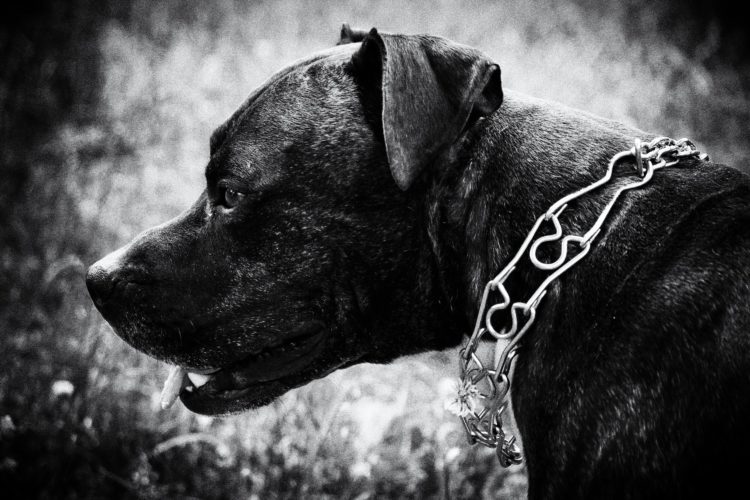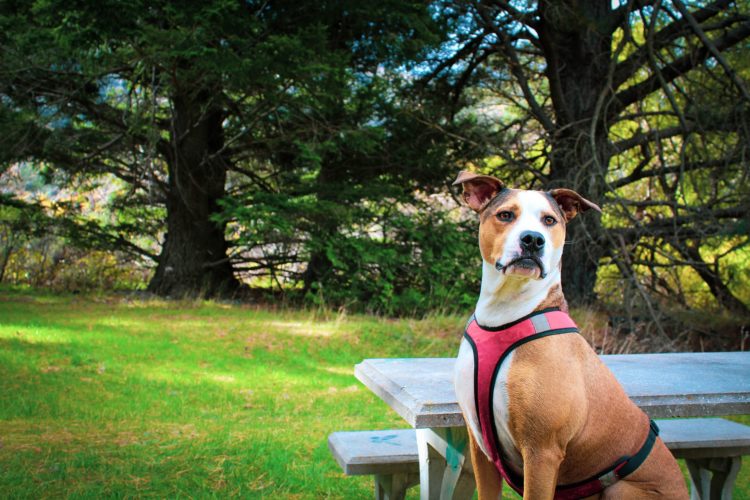Let’s Talk About the Benefits of Leather Dog Collars
Your dog’s collar is much more than a fashion statement.
Selecting the best option is one of the most important decisions you’ll make, in fact.
There’s an endless range of materials, styles, sizes, and colors to choose from, but we believe that leather dog collars are the best possible option.
We’ll tell you why, but first, let’s explore the many purposes and benefits of putting a great collar on your dog.
Dogs need to wear a collar for their health and safety
Dog collars fulfil many roles. They’re a relatively safe way to restrain your dog when out walking, or when you need to tether them in an unfenced area so they don’t get into trouble.
They’re also important for carrying your dog’s identification. It says, “I have a home where I belong and where I am loved.”
When someone sees a stray dog roaming around, if it has a collar they know it belongs to someone even if it’s running loose at the moment.
But if your dog gets lost, then it could mean the difference between animal control being called and your dog dying because they can’t find their owner, or not.
If your poor pup gets lost they’ll be returned to you more quickly if you have a contact number on their tag. And, since you’ll probably have their name on it, the person who found your furry friend will be able to comfort them using the one word they know best. This will help reduce the dog’s anxiety…because you can bet they’re just as worried as you are in that moment.
If you’re conscientious about the safety of your companion, you probably have your dog tattooed or microchipped, but the tag on their collar will speed up the reunion.
Even if you don’t intend to turn your pet into an agility or show dog, you’ll want a good quality leather dog collar and leash for basic training.
Your dog won’t get into scraps with other dogs while you’re on a walk, dart away from you and race into traffic, or jump up on your elderly neighbor, or your best friend’s toddler, if they’ve been well-trained. You’ll need a collar and leash and good training skills for that to happen properly.
Why leather dog collars are the healthiest option for your dog
Leather dog collars are lightweight, pliable, easy to clean, made of all-natural material (or leather feel quality materials), and come in a wide variety of sizes and styles.
Of all the alternative materials – nylon weave, fabric, chain metal – we have to make one thing perfectly clear: chain dog collars are a hazard and should be avoided completely.
Not only do chain collars simply try to mask a poorly-trained dog’s bad behavior, they actually do physical and emotional harm to your dog, especially choker-styles and pinch collars…
They’ve been proven to cause serious injuries, including:

- Fractured and crushed larynx
- Asphyxiation
- Crushed trachea
- Whiplash
- Spinal cord trauma
- Fainting
- Prolapsed eyes
- Dislocated neck bones
Pinch collars – or collars with inner spikes – are extremely dangerous. Since dogs have little feeling in the skin around their neck they can develop a tolerance to the pinching sensation. Being hurt around their neck also mimics being bitten by another animal which can increase their reactivity and aggression too.
Not only will your dog’s pulling – or other unwanted behavior – continue, they’ll potentially develop skin inflammation, open sores, and serious disease.
In fact, these collars often make a dog more aggressive or fearful, making a bad situation even worse. Just forget about chain dog collars and move on to a more humane and practical option.
Fabric or weave collars typically shut with a sliding buckle. The problem is, they slide and can come loose over time. That’s a bad thing, because then they no longer fit properly and can easily come off your dog… and that? Defeats the purpose entirely.
Care and maintenance of your leather dog collar
Leather dog collars might be a little more expensive, but they last longer if you take proper care of them. Whether you buy an unfinished or finished collar, some simple cleaning will extend the life of your collar.
Not sure which kind you have? The unfinished collar will be dull, the finished leather will be shiny or glossy.
Cleaning unfinished leather:
- Avoid using water for cleaning.
- Use saddle soap and work it into the leather with a dry, soft cloth.
- Wipe the soap away with a clean, dry cloth.
- Once it’s dry and clean, rub leather wax on the collar.
Cleaning finished leather:
- Use a damp cloth with mild dish detergent to wipe off dirt and mud.
- Use a stiff-bristled brush with detergent for stubborn stains.
- Remove all soap and residue with a clean, damp cloth.
- Buff it back to a shine with a dry, soft cloth.
- For added protection, apply a dog safe preservative or conditioner. Then buff again until shiny.
Things to keep in mind when buying leather dog collars
You probably have a local store that sells good quality leather dog collars, but if you don’t, check out some of the online options. A knowledgeable retailer or website will be able to guide you to the right size, weight, and material for your particular dog’s breed, age, and behaviors.
All the leather collars will be more durable and flexible than their fabric counterparts, but you don’t want a narrow collar on a dog that likes to pull, or a big, fat, jewel-studded collar on your puppy, whose bones are still quite malleable.
Remember that for your puppy or rescue dog the feeling of something around their neck may be very foreign – choose a lightweight, soft leather collar and ease into something more substantial as they adjust to the new sensation.
It also helps to praise them by telling them how wonderful they look in it. And as always, communicating with your dog about why you’d like them to wear a collar, what it’s good for, and what the tag(s) say is always a good thing.
I’ve found that if they understand why it’s important, that even if it gets loose later and could come off easily? They will make the effort to keep it on their neck because they understand it’s purpose.
The danger of training with a collar
If your dog continues to pull and choke themselves on a collar and lead, or they are so strong they drag you down the street or knock you over, then you’ve got a serious problem.
Not only will your dog get hurt – often their neck is pulled out of alignment and you’ll need a good chiropractor to realign their spine – you can get hurt too.
Get some help from a positive dog trainer so you know how to teach them to heel properly on lead.
But what if you can’t or have tried all the right stuff and your dog still pulls? If that’s you and your dog, then consider using a harness instead.
So what about using a harness for your dog?
A good dog harness can be a great solution to avoid the problem that collars can cause when on a leash.
The bad news is, not all harnesses are created equally. You want the right harness.
For instance, dog harnesses with leash clips positioned on the dog’s back or shoulders are a terrible idea… unless you want your dog to be a sled dog dragging you down the street with all their weight and strength! No? I didn’t think so.
You also don’t want a harness that clips in front low between their front legs. Another terrible design flaw unless you enjoy watching your dog trip over the leash and get tangled up. It might slow them down, but it’s terrible frustrating to them and you when you have to untangle them every few steps.
The best dog harness clips up high on the chest, below the neck. The reason is that when the dog pulls against the harness, the harness itself blocks the forward action. When a dog leans against something pulling back against their chest, they naturally back up a bit. Their instinct is to lean away from the pressure.
That’s exactly what you want. When they back away from pressure, you can recall them to you in the proper heel position and redirect them to follow your lead.
This is a good example of a better designed harness, check it out here. Or this one here.
Remember that collars and harnesses are just one tool to help teach good behavior
Good leash manners are important, even if you’re raising a farm dog. Training your dog can be fun and a great bonding experience for both of you.
It’s important to keep in mind, though, that sometimes a dog’s bad behavior is a sign of something other than a bad attitude. And there are many ways to work with your pet and teach good behavior beyond leash training.
All pets are constantly sending us messages about their sense of well-being, and their sense of your well-being. Pets mirror their masters.
If your ordinarily calm dog is suddenly acting aggressively, pulling on the leash during walks or tuning you out, take time to figure out what else is going on – both in your pup’s world and yours.
If you’re having a hard time reading your pet’s signals, get a professional to help you out – a veterinarian or pet communicator. Better yet, take the time to learn the language your dog is speaking to you.
It’s possible that you could be a pet communicator and benefit from the rich and interesting conversations you can have with your four-legged companions.
If you’d like more information, contact us…let’s communicate with your dog!
Did you enjoy this article? Here are some more to help with your fluffy companions:
Buddy’s Story: Our Experience Fostering A Puppy Mill Dog
Everything You Need To Know About Kidney and Liver Failure in Dogs
Dog Games: 10 Fun Ways to Learn & Bond for Puppy and Child
. . .
Affiliate Disclaimer: This post contains affiliate information which means that I’ll earn a small commission if you purchase at no extra cost to you.
The post The Benefits of Leather Dog Collars appeared first on Val Heart.
source https://valheart.com/benefits-of-leather-dog-collars-vs-other-materials/


No comments:
Post a Comment